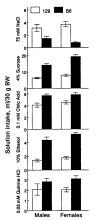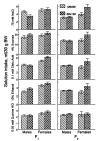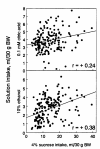Intake of ethanol, sodium chloride, sucrose, citric acid, and quinine hydrochloride solutions by mice: a genetic analysis
- PMID: 8990535
- PMCID: PMC3661408
- DOI: 10.1007/BF02361229
Intake of ethanol, sodium chloride, sucrose, citric acid, and quinine hydrochloride solutions by mice: a genetic analysis
Abstract
Mice of the 129/J (129) and C57BL/6ByJ (B6) strains and their reciprocal F1 and F2 hybrids were offered solutions of ethanol, sucrose, citric acid, quinine hydrochloride, and NaCl in two-bottle choice tests. Consistent with earlier work, the B6 mice drank more ethanol, sucrose, citric acid, and quinine hydrochloride solution and less NaCl solution than did 129 mice. Analyses of each generation's means and distributions showed that intakes of ethanol, quinine, sucrose, and NaCl were influenced by a few genes. The mode of inheritance was additive in the case of ethanol and quinine, for sucrose the genotype of the 129 strain was recessive, and for NaCl it was dominant. Citric acid intake appeared to be influenced by many genes with small effects, with the 129 genotype dominant. Correlations of sucrose consumption with ethanol and citric acid consumption were found among mice of the F2 generation, and the genetically determined component of these correlations was stronger than the component related to environmental factors. The genetically determined correlation between sucrose and ethanol intakes is consistent with the hypothesis that the higher ethanol intake by B6 mice depends, in part, on higher hedonic attractiveness of its sweet taste component.
Figures





References
-
- Azen EA. Linkage studies of genes for salivary proline-rich proteins and bitter taste in mouse and human. In: Wysocki CJ, Kare MR, editors. Chemical Senses. vol. 3: Genetics of Perception and Communication. Marcel Dekker; New York: 1988. pp. 279–290.
-
- Bachmanov AA, Dmitriev Yu.S. Genetic analysis of some behavioral and physiological traits in hybrids between hypertensive and normotensive rats: Analysis of the inheritance nature. Genetika. 1992a;28:150–159. (in Russian) - PubMed
-
- Bachmanov AA, Dmitriev Yu. S. Genetic analysis of some behavioral and physiological traits in hybrids between hypertensive and normotensive rats: Analysis of reciprocal differences. Genetika. 1992b;28:120–127. (in Russian) - PubMed
-
- Bachmanov AA, Tordoff MG, Beauchamp GK. Strain differences in salt appetite in mice. Abstracts of the 2nd Independent Meeting of the SSIB; Hamilton, Canada. 1994. pp. A–24.
Publication types
MeSH terms
Substances
Grants and funding
LinkOut - more resources
Full Text Sources
Medical
Molecular Biology Databases
Miscellaneous
